Xero Bundle
How Did Xero Conquer the Cloud Accounting World?
Before spreadsheets and manual ledgers faded into the digital sunset, a revolutionary force emerged. This force, Xero, dared to challenge the status quo in accounting. Discover the fascinating Xero SWOT Analysis, a company that transformed how small businesses manage their finances, ushering in a new era of cloud accounting.
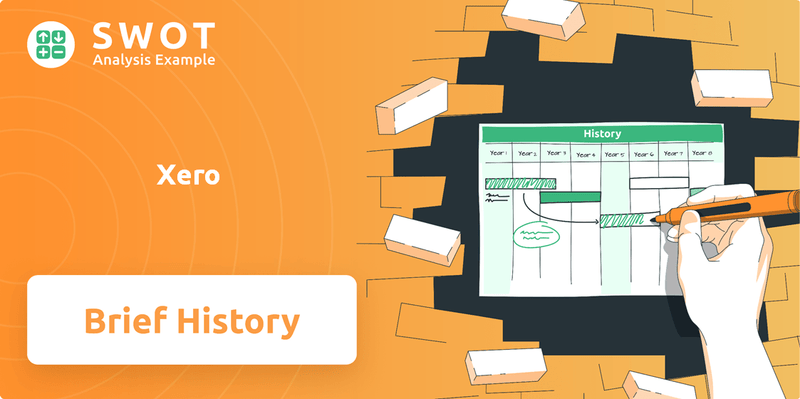
The story of Xero, from its humble beginnings in New Zealand to its global dominance, is a compelling narrative of innovation and strategic execution. Understanding the Xero history reveals how Xero company disrupted the accounting software market. This brief history of Xero accounting software highlights key milestones, the Xero founders' vision, and the evolution of Xero features that propelled its growth, making it a leader in the cloud accounting space.
What is the Xero Founding Story?
The story of the Xero company begins on July 19, 2006, in Wellington, New Zealand. Rod Drury, the Xero founder, a seasoned entrepreneur, saw an opportunity to revolutionize accounting. He aimed to create a simple, cloud-based accounting system.
Drury recognized that existing accounting software was often complicated and not well-suited for modern businesses. His vision was to provide a user-friendly solution that allowed small businesses to manage their finances from anywhere. This marked the beginning of Xero's journey to transform the accounting landscape.
The initial goal of Xero was to address the cumbersome nature of traditional accounting software. This software often required manual updates and lacked real-time data visibility. Xero leveraged cloud technology to offer a more efficient and user-friendly solution. The business model was built on a subscription service, providing access to its cloud-based accounting platform for a recurring fee. The first product offered core functionalities like invoicing and bank reconciliation.
Xero's name was chosen for its simplicity and global appeal, reflecting its aim to simplify accounting. Initial funding came from a seed round, with significant contributions from Drury and investments from friends and family.
- The founding team's expertise in software development and business strategy was crucial.
- Xero's early focus was on core accounting functions.
- The company aimed to provide real-time financial data to its users.
- Xero's cloud-based approach set it apart from competitors.
Xero's early success can be attributed to its innovative approach to cloud accounting. The company's focus on user-friendliness and accessibility quickly gained traction. By 2024, Xero had grown significantly, with a substantial global presence. The company's impact on small businesses has been profound, offering them tools to manage their finances more efficiently. To understand who Xero's target market is, read about the Target Market of Xero.
As of 2024, Xero continues to be a leading player in the cloud accounting market, with a focus on innovation and customer satisfaction. The company's history reflects a commitment to simplifying accounting and empowering small businesses worldwide.
Xero SWOT Analysis
- Complete SWOT Breakdown
- Fully Customizable
- Editable in Excel & Word
- Professional Formatting
- Investor-Ready Format
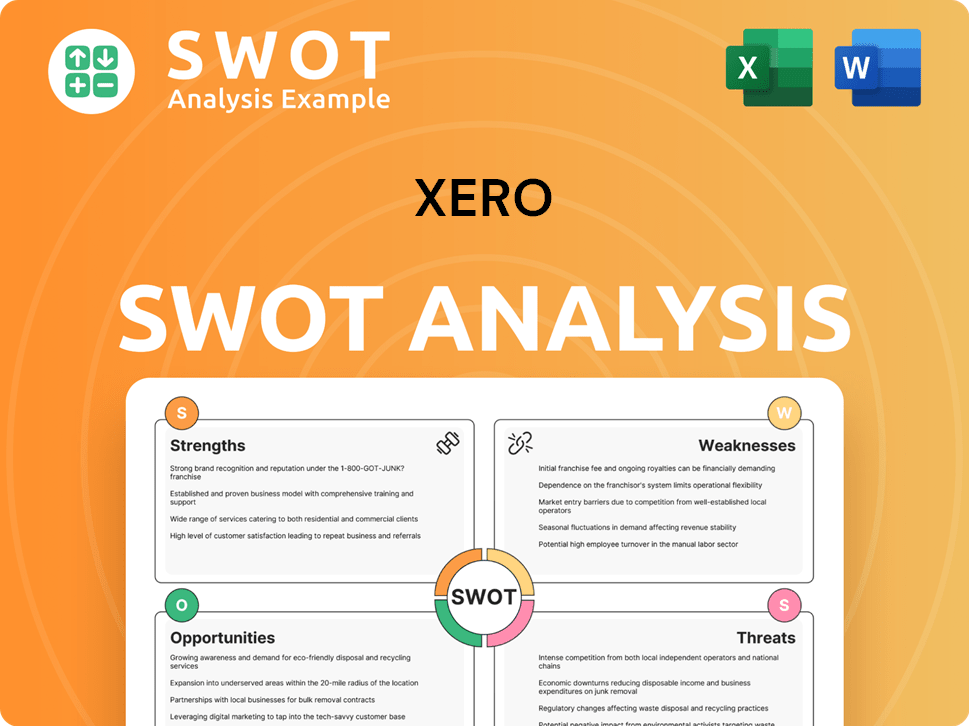
What Drove the Early Growth of Xero?
The early growth of the Xero company was marked by swift development and expansion. From its inception, the firm quickly transformed its initial concepts into a functional product, driven by positive market reception and strategic moves. This phase was crucial in establishing Xero as a key player in the cloud accounting sector. The company's trajectory involved significant milestones, including securing funding and expanding its geographical footprint.
Xero's initial focus was on developing a Minimum Viable Product (MVP) that concentrated on core accounting functions. Early user feedback was essential in shaping product iterations, leading to continuous enhancements in usability and features. This iterative approach allowed Xero to rapidly adapt and improve its offerings based on real-world user experiences. The company prioritized cloud accounting features to differentiate itself.
The company's customer acquisition strategy initially targeted small businesses and accounting professionals who were open to cloud technologies. Xero leveraged word-of-mouth referrals and strategic partnerships with accounting firms to grow its user base. By focusing on these channels, Xero effectively built a strong foundation for its early growth. The Growth Strategy of Xero involved partnerships.
In 2008, Xero secured its first major capital raise and was listed on the New Zealand Exchange (NZX), which provided essential funding for further development and expansion. This funding allowed for significant team expansion, including key hires in engineering, sales, and marketing. Geographical expansion began with a focus on Australia, followed by the United Kingdom and the United States.
By 2012, Xero had surpassed 100,000 paying subscribers, demonstrating strong growth metrics. This period also saw early integrations with other business applications, foreshadowing Xero's future ecosystem approach. The company's growth was shaped by a competitive landscape that included established players like QuickBooks and MYOB. Xero differentiated itself through its cloud-native architecture and user experience.
Xero PESTLE Analysis
- Covers All 6 PESTLE Categories
- No Research Needed – Save Hours of Work
- Built by Experts, Trusted by Consultants
- Instant Download, Ready to Use
- 100% Editable, Fully Customizable
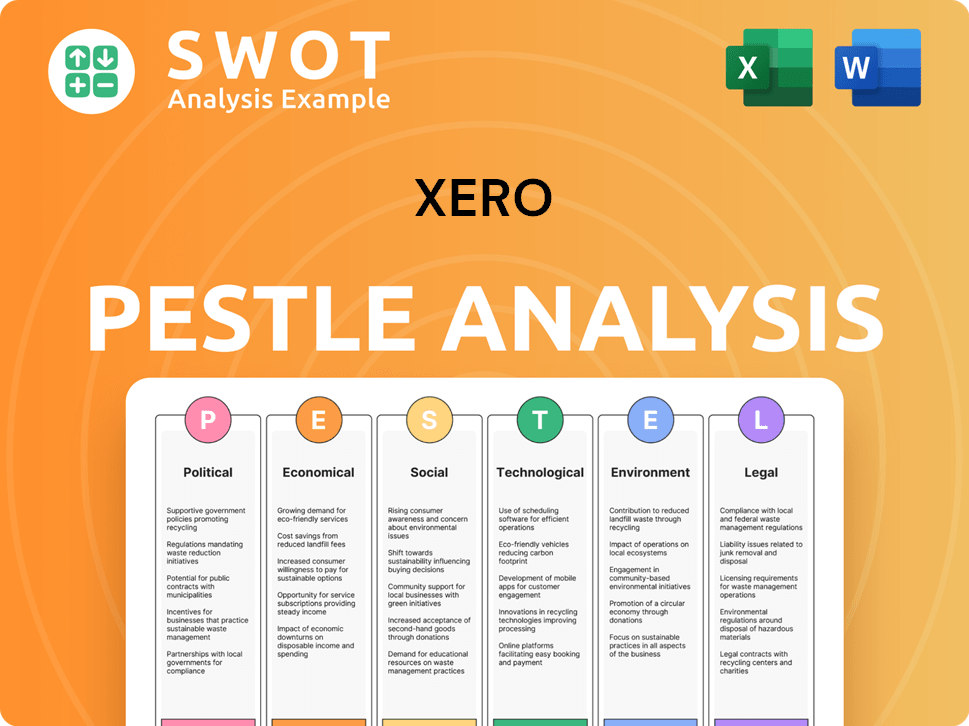
What are the key Milestones in Xero history?
The Xero history is marked by significant achievements, innovative strides, and overcoming various challenges. The company's journey has been one of continuous evolution, adapting to market dynamics and technological advancements. From its early days to its current status as a leading cloud accounting provider, the Xero company has consistently pushed boundaries and set new standards in the industry.
| Year | Milestone |
|---|---|
| 2006 | Xero was founded in Wellington, New Zealand, by Rod Drury and Hamish Edwards. |
| 2007 | The first version of Xero's cloud accounting software was launched. |
| 2010 | Xero expanded into the Australian market. |
| 2012 | Xero had its initial public offering (IPO) on the New Zealand Stock Exchange. |
| 2018 | The company appointed Steve Vamos as CEO. |
| 2023 | Sukhinder Singh Cassidy became the CEO of Xero. |
Xero's commitment to innovation is evident in its Xero features and technological advancements. A key innovation was its early adoption of a true cloud-based architecture, which set it apart from traditional desktop software.
Xero pioneered a true cloud-based architecture, enabling real-time collaboration and automatic updates. This innovation allowed users to access their financial data from anywhere, at any time, revolutionizing how small businesses managed their finances.
The integration of bank feeds automated the reconciliation process, saving users significant time and reducing manual data entry. This feature streamlined financial management and improved accuracy.
Xero implemented machine learning to automate and improve bank reconciliation processes. This feature intelligently matched transactions, further reducing manual effort and enhancing efficiency.
Xero developed advanced reporting features, providing users with powerful tools to analyze their financial data. These features offered insights into business performance, supporting better decision-making.
Xero established major partnerships with financial institutions and other software providers. These partnerships expanded the platform's capabilities and provided users with a comprehensive suite of tools.
Xero offered robust mobile apps, enabling users to manage their finances on the go. This accessibility enhanced convenience and flexibility for small business owners.
The Xero accounting software faced several challenges throughout its history, including market downturns and competitive pressures. These challenges required strategic adjustments and continuous innovation to maintain its market position.
The global financial crisis and other economic downturns impacted small business growth, affecting Xero's customer base and revenue. These events necessitated careful financial planning and strategic adjustments.
Competition from established players and new entrants in the cloud accounting space required continuous product development and strategic agility. The company had to innovate constantly to stay ahead.
Achieving product-market fit in diverse international markets presented challenges, requiring localization efforts and understanding varying regulatory landscapes. Adapting to different tax systems and compliance requirements across countries was a significant hurdle.
Transitions in leadership, such as the move from Rod Drury to Steve Vamos and then to Sukhinder Singh Cassidy, marked strategic shifts in the company's focus and global expansion. These changes required adapting to new visions and strategies.
The rapidly evolving technological landscape demanded continuous investment in research and development to stay relevant. Xero had to adapt to new technologies and integrate them into its platform.
Expanding its partner program to deeply integrate with accounting firms was a strategic pivot to overcome challenges. This move strengthened the company's ecosystem and provided better support to its users.
Xero Business Model Canvas
- Complete 9-Block Business Model Canvas
- Effortlessly Communicate Your Business Strategy
- Investor-Ready BMC Format
- 100% Editable and Customizable
- Clear and Structured Layout
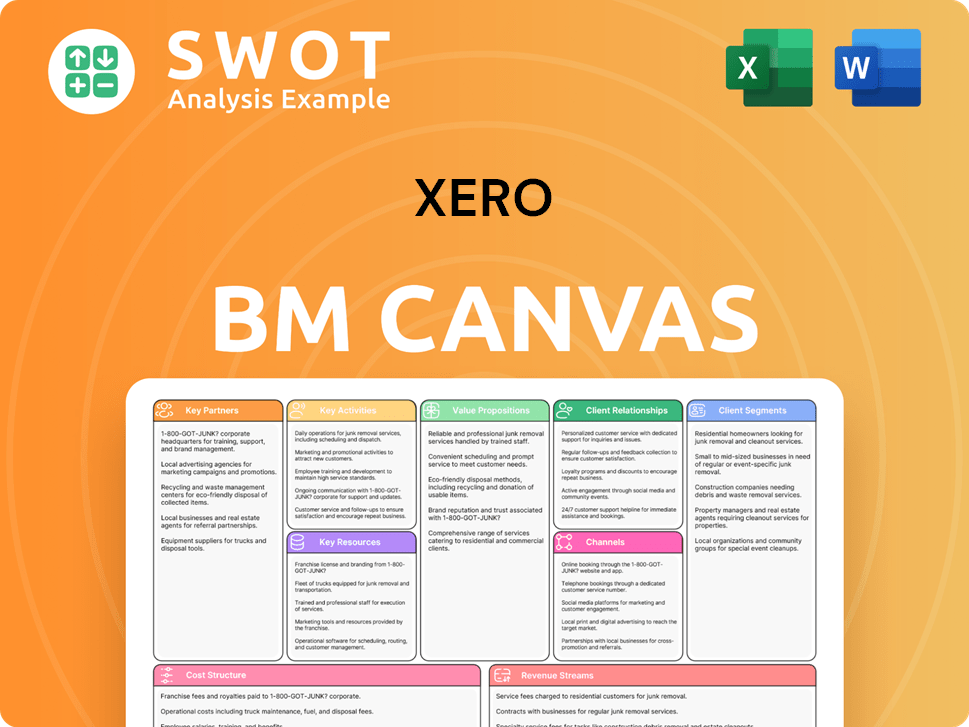
What is the Timeline of Key Events for Xero?
The Xero company has a rich history, marked by strategic expansions and technological advancements. Founded in 2006 by Rod Drury, the cloud accounting software quickly gained traction, leading to its listing on the New Zealand Exchange in 2007. Over the years, Xero expanded globally, reaching key milestones such as surpassing 100,000 subscribers in 2012 and 2 million subscribers by 2020. In 2023, Sukhinder Singh Cassidy took over as CEO, and as of September 30, 2023, the company reported 4.2 million subscribers worldwide, with NZ$799.5 million in revenue for the first half of FY24.
| Year | Key Event |
|---|---|
| 2006 | Founded by Rod Drury in Wellington, New Zealand, marking the beginning of the Xero accounting software journey. |
| 2007 | Listed on the New Zealand Exchange (NZX) to raise capital for expansion. |
| 2008 | Launched its first cloud-based accounting software product, revolutionizing the industry. |
| 2009 | Expanded its operations into Australia, a key step in its international growth strategy. |
| 2011 | Established a presence in the United Kingdom, further extending its global reach. |
| 2012 | Surpassed 100,000 paying subscribers globally, demonstrating significant market adoption. |
| 2013 | Expanded into the United States, tapping into a major market for cloud accounting. |
| 2015 | Achieved 500,000 subscribers worldwide, reflecting its growing popularity. |
| 2018 | Delisted from the NZX and listed solely on the Australian Securities Exchange (ASX). |
| 2020 | Surpassed 2 million subscribers globally, showcasing substantial user growth. |
| 2023 | Announced Sukhinder Singh Cassidy as CEO, signaling a new phase of leadership. |
| 2024 | Reported 4.2 million subscribers globally as of September 30, 2023, with revenue of NZ$799.5 million for the first half of FY24. |
Xero is prioritizing the enhancement of its platform, especially in areas like AI-driven insights, payments, and financial services integration. This includes the development of more sophisticated tools to assist small businesses. The goal is to provide a comprehensive financial management solution.
Xero plans to continue expanding its reach in existing key markets while exploring new growth opportunities. This involves increasing its customer base and strengthening its presence in regions where it already operates. The strategy includes tailored solutions for different markets.
Xero aims to utilize its extensive data to offer more personalized and proactive insights to small businesses. This will help automate accounting processes and provide valuable financial guidance. The focus is on using data to improve user experience.
The increasing adoption of cloud technology and the demand for real-time financial data will significantly impact Xero's future. Analysts predict continued growth in the cloud accounting sector, with Xero well-positioned to capitalize on this trend. Xero's commitment to innovation is a key factor.
Xero Porter's Five Forces Analysis
- Covers All 5 Competitive Forces in Detail
- Structured for Consultants, Students, and Founders
- 100% Editable in Microsoft Word & Excel
- Instant Digital Download – Use Immediately
- Compatible with Mac & PC – Fully Unlocked
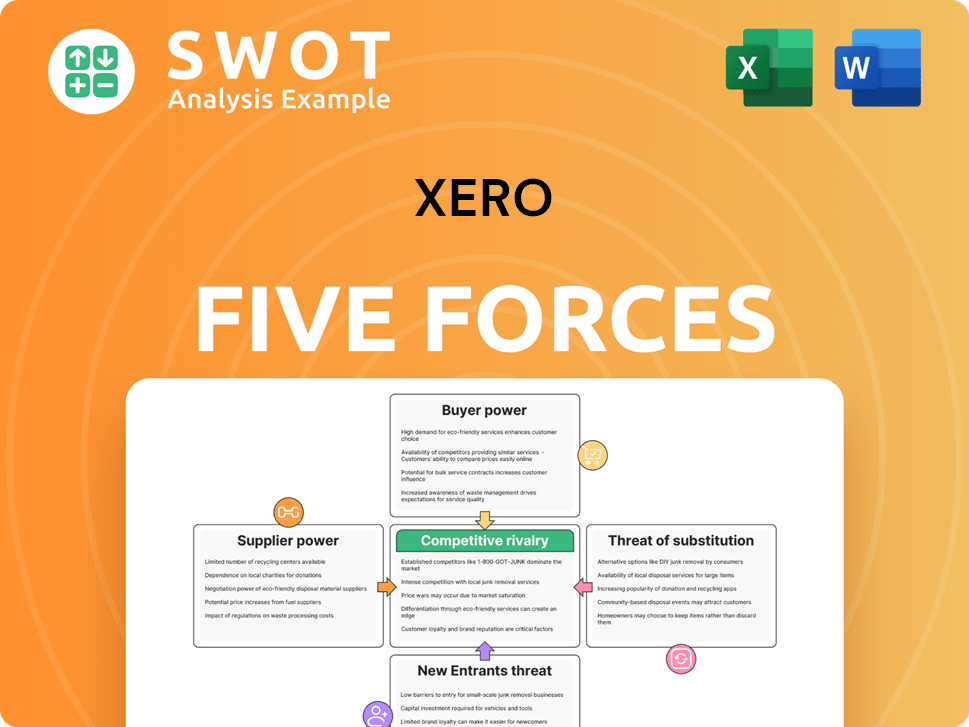
Related Blogs
- What is Competitive Landscape of Xero Company?
- What is Growth Strategy and Future Prospects of Xero Company?
- How Does Xero Company Work?
- What is Sales and Marketing Strategy of Xero Company?
- What is Brief History of Xero Company?
- Who Owns Xero Company?
- What is Customer Demographics and Target Market of Xero Company?
Disclaimer
All information, articles, and product details provided on this website are for general informational and educational purposes only. We do not claim any ownership over, nor do we intend to infringe upon, any trademarks, copyrights, logos, brand names, or other intellectual property mentioned or depicted on this site. Such intellectual property remains the property of its respective owners, and any references here are made solely for identification or informational purposes, without implying any affiliation, endorsement, or partnership.
We make no representations or warranties, express or implied, regarding the accuracy, completeness, or suitability of any content or products presented. Nothing on this website should be construed as legal, tax, investment, financial, medical, or other professional advice. In addition, no part of this site—including articles or product references—constitutes a solicitation, recommendation, endorsement, advertisement, or offer to buy or sell any securities, franchises, or other financial instruments, particularly in jurisdictions where such activity would be unlawful.
All content is of a general nature and may not address the specific circumstances of any individual or entity. It is not a substitute for professional advice or services. Any actions you take based on the information provided here are strictly at your own risk. You accept full responsibility for any decisions or outcomes arising from your use of this website and agree to release us from any liability in connection with your use of, or reliance upon, the content or products found herein.